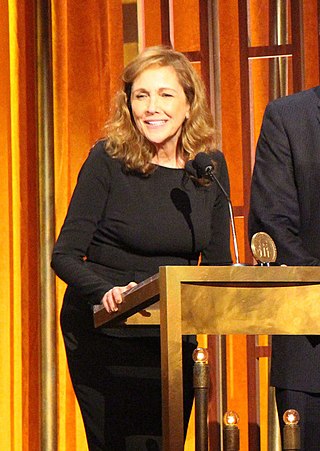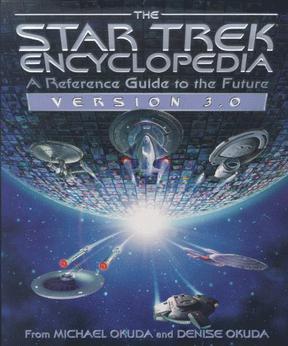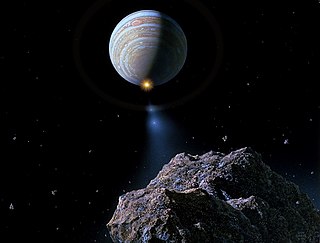
Ann Druyan is an American documentary producer and director specializing in the communication of science. She co-wrote the 1980 PBS documentary series Cosmos, hosted by Carl Sagan, whom she married in 1981. She is the creator, producer, and writer of the 2014 sequel, Cosmos: A Spacetime Odyssey and its sequel series, Cosmos: Possible Worlds, as well as the book of the same name. She directed episodes of both series.

Carl Edward Sagan was an American astronomer, planetary scientist and science communicator. His best known scientific contribution is his research on the possibility of extraterrestrial life, including experimental demonstration of the production of amino acids from basic chemicals by exposure to light. He assembled the first physical messages sent into space, the Pioneer plaque and the Voyager Golden Record, which were universal messages that could potentially be understood by any extraterrestrial intelligence that might find them. He argued in favor of the hypothesis, which has since been accepted, that the high surface temperatures of Venus are the result of the greenhouse effect.
A googolplex is the large number 10googol, or equivalently, 1010100 or 1010,000,000,000,000,000,000,000,000,000,000,000,000,000,000,000,000,000,000,000,000,000,000,000,000,000,000,000,000,000,000,000,000,000. Written out in ordinary decimal notation, it is 1 followed by 10100 zeroes; that is, a 1 followed by a googol of zeroes. Its prime factorization is 2googol ×5googol.

The Voyager program is an American scientific program that employs two interstellar probes, Voyager 1 and Voyager 2. They were launched in 1977 to take advantage of a favorable planetary alignment to explore the two gas giants Jupiter and Saturn and potentially also the ice giants, Uranus and Neptune - to fly near them while collecting data for transmission back to Earth. After Voyager 1 successfully completed its flyby of Saturn and its moon Titan, it was decided to send Voyager 2 on flybys of Uranus and Neptune.

The Voyager Golden Records are two identical phonograph records which were included aboard the two Voyager spacecraft launched in 1977. The records contain sounds and data to reconstruct raster scan images selected to portray the diversity of life and culture on Earth, and are intended for any intelligent extraterrestrial life form who may find them. The records are a time capsule.

Cosmos: A Personal Voyage is a thirteen-part, 1980–81 television series written by Carl Sagan, Ann Druyan, and Steven Soter, with Sagan as presenter. It was executive-produced by Adrian Malone, produced by David Kennard, Geoffrey Haines-Stiles, and Gregory Andorfer, and directed by the producers, David Oyster, Richard Wells, Tom Weidlinger, and others. It covers a wide range of scientific subjects, including the origin of life and a perspective of our place in the universe. Owing to its bestselling companion book and soundtrack album using the title, Cosmos, the series is widely known by this title, with the subtitle omitted from home video packaging. The subtitle began to be used more frequently in the 2010s to differentiate it from the sequel series that followed.

The Pioneer plaques are a pair of gold-anodized aluminum plaques that were placed on board the 1972 Pioneer 10 and 1973 Pioneer 11 spacecraft, featuring a pictorial message, in case either Pioneer 10 or 11 is intercepted by intelligent extraterrestrial life. The plaques show the nude figures of a human male and female along with several symbols that are designed to provide information about the origin of the spacecraft.

The Star Trek Encyclopedia: A Reference Guide to the Future is a 1994 encyclopedia of in-universe information from the Star Trek television series and films. It was written by Michael Okuda and Denise Okuda, who were production staff on Star Trek: The Next Generation, Star Trek: Deep Space Nine and Star Trek: Voyager and Debbie Mirek. It was illustrated by Doug Drexler.

A barred spiral galaxy is a spiral galaxy with a central bar-shaped structure composed of stars. Bars are found in about two thirds of all spiral galaxies in the local universe, and generally affect both the motions of stars and interstellar gas within spiral galaxies and can affect spiral arms as well. The Milky Way Galaxy, where the Solar System is located, is classified as a barred spiral galaxy.

Pale Blue Dot is a photograph of Earth taken on February 14, 1990, by the Voyager 1 space probe from an unprecedented distance of approximately 6 billion kilometers, as part of that day's Family Portrait series of images of the Solar System.

Nicholas Julian Zapata Sagan is an American novelist and screenwriter. He is the author of the science fiction novels Idlewild, Edenborn, and Everfree, and has also written scripts for episodes of Star Trek: The Next Generation and Star Trek: Voyager. He is the son of astronomer Carl Sagan and artist and writer Linda Salzman.

Don Davis is a space artist known for his portrayals of space-related subjects. His work is characterised by attention to detail and authentic portrayals based on what is known of the subject. Chesley Bonestell, considered by many to be one of the most accomplished practitioners of the space art genre, critiqued Davis' early paintings and encouraged him to pursue an artistic career.

"Flashback" is the 44th episode of the American science fiction television series Star Trek: Voyager airing on the UPN network. It is the second episode of the third season.

Pale Blue Dot: A Vision of the Human Future in Space is a 1994 book by the astronomer Carl Sagan. It is the sequel to Sagan's 1980 book Cosmos and was inspired by the famous 1990 Pale Blue Dot photograph, for which Sagan provides a poignant description. In the book, Sagan mixes philosophy about the human place in the universe with a description of the current knowledge about the Solar System. He also details a human vision for the future.
Jon Lomberg is an American space artist and science journalist. He was Carl Sagan's principal artistic collaborator for more than twenty years on many projects from 1972 through 1996. In 1998, the International Astronomical Union officially named an asteroid in recognition of his achievements in science communication. He was NASA's Design Director for the Golden Record on the Voyager spacecraft; the cover he designed is expected to last at least a billion years.

David Michael Jacobs is an American historian and retired Associate Professor of History at Temple University specializing in 20th-century American history. Jacobs is a prominent figure in ufology and the study of the alien abduction phenomenon, including the use of hypnosis on subjects claiming to be abductees. Jacobs has authored several books on the subject.

The Symphony of Science is a music project created by Washington-based electronic musician John D. Boswell. The project seeks to "spread scientific knowledge and philosophy through musical remixes." Boswell uses pitch-corrected audio and video samples from television programs featuring popular educators and scientists. The audio and video clips are mixed into digital mashups and scored with Boswell's original compositions. Two of Boswell's music videos, "A Glorious Dawn" and "We are All Connected", feature appearances from Carl Sagan, Richard Feynman, Neil deGrasse Tyson, Bill Nye, and Stephen Hawking. The audio and video is sampled from popular science television shows including Cosmos, The Universe, The Eyes of Nye, The Elegant Universe, and Stephen Hawking's Universe.

The Voyager Golden Record contains 116 images and a variety of sounds. The items for the record, which is carried on both the Voyager 1 and Voyager 2 spacecraft, were selected for NASA by a committee chaired by Carl Sagan of Cornell University. Included are natural sounds, musical selections from different cultures and eras, spoken greetings in 59 languages, human sounds like footsteps and laughter, and printed messages from President Jimmy Carter and U.N. Secretary-General Kurt Waldheim.
"Standing Up in the Milky Way" is the first aired episode of the American documentary television series Cosmos: A Spacetime Odyssey. It premiered on March 9, 2014, simultaneously on various Fox television networks, including National Geographic Channel, FX, Fox Life, and others. The episode is presented by the series host astrophysicist Neil deGrasse Tyson, directed by Brannon Braga, produced by Livia Hanich and Steven Holtzman, and written by Ann Druyan and Steven Soter.
List of works by or about Timothy Ferris, American science writer.















